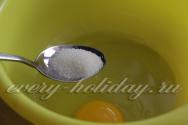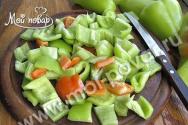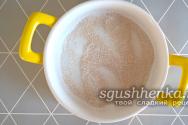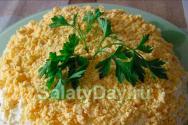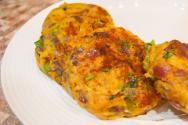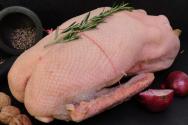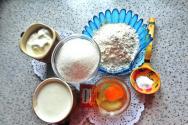A simple recipe for Easter cake with kefir. How to bake “Peerless” Easter cake with kefir. Amazing Easter baked goods with kefir
Kulich is a traditional dish, which is prepared in Russia for Easter. In recent years, many people prefer to buy Easter cakes in supermarkets and bakery stores. It's easy and quick, and the cake is quite inexpensive. But if the housewife still decides to devote her time and effort to preparing her own Easter cake, then the result will be much more tasty and festive than the purchased version. If you are preparing Easter cake with kefir, the recipe will be simple and not require much time, and the baked goods will turn out very tender and tasty.
This recipe can be used to make a classic Easter cake. If you want to do a variation of this sweet pastries with raisins, dried apricots or other additives, the process will not be much different. By following the instructions, you can prepare a truly unique dish.
Easter cakes made with kefir have a fairly inexpensive list of ingredients.
- kefir (at least 2.5% fat) - 2 cups, or 400 ml;
- flour - 4 cups, or 800 g;
- eggs - 2 pieces;
- sugar - 7–8 tbsp. spoon;
- butter (at least 72% fat) - 6 tbsp. spoon;
- salt - 0.5 teaspoon;
- dry yeast - 1 package (10–12 g);
- vanillin - 1 g.
Fondant that decorates baked goods requires separate ingredients.
Dried fruits are often added to the dough. The most popular are raisins and dried apricots, but people often prepare cakes with prunes or candied fruits. The addition of these ingredients does not change the main list.
Dried fruits are simply added to the dough at the kneading stage. The baking technology remains unchanged.
Step-by-step cooking recipe
Housewives who often bake can certainly cook Easter cake without outside help. The instructions below will be more useful for culinary beginners. By following these detailed steps, you can prepare a traditional and delicious Easter cake without any hassle.
So, first things first.
- Pour the packet of dry yeast into a fairly deep bowl. Add flour and mix.
- Beat the eggs and sugar until the sugar crystals are completely dissolved. If you don’t have a mixer, it’s easier to take powdered sugar: You won’t have to beat it for so long. Pour the resulting mixture into another bowl.
- Add preheated kefir to the egg-sugar mixture. The temperature of the liquid should not exceed 40 degrees, otherwise the kefir will curdle.
- Pour the mixture into a bowl with flour and yeast. It is better to do this in small portions for 1-2 minutes. Do not mix flour and eggs before adding kefir to the eggs. Otherwise, the dough may not work out.
- Mix the dough. If you use dried fruits, then you need to add them at this stage - before kneading.
- Place the dough in a warm area of the room (can be on or next to a radiator) for about 1 hour.
- Posting ready dough on the table, pre-lubricated olive oil. However, you can also take sunflower. We also use it to grease the cake pans. Molds made of steel, silicone or baking paper are best suited for this.
- Divide the dough into portions, knead moderately and arrange into molds. Leave in a warm place for about 30 minutes. The same battery or stove with the oven on is suitable for this.
- After the dough in the molds has approximately doubled in size, place the future Easter cakes in a preheated oven. Optimal temperature for baking - 180 degrees.
You need to bake the cakes for about 40 minutes, but it all depends on the size of the molds. If they are small, then half an hour may be enough, and if they are large, then it will take all of 50 minutes. To check the dish for readiness, you can use a wooden stick (alternatively, a match or a toothpick). Just dip its tip into the dough, and if it comes out dry, without lumps or moisture, then the cake is ready.
If you have a bread machine at home, the Easter cake recipe will be even simpler. You must first pour all the liquid ingredients into the oven compartment for dough, and then add all the dry ones, then you need to set the mode as for regular bread. The machine will do the rest itself, and the housewife will receive ready-made dough.
Making fudge for Easter cakes
A separate stage of baking Easter cake is the preparation of fondant, or glaze. This should be done when the dish is already baking. Carefully separate the whites from the yolks and beat with a mixer until fluffy foam. You can beat the whites by hand, but in a mixer it will only take 4-5 minutes, while with a whisk it will take much longer. In order for the whites to whip better, the eggs should be cool, just out of the refrigerator.
Gradually add powdered sugar to the resulting foam. You can use regular sugar, but with powder the fudge will be softer. Add a pinch of salt and beat well again. To check if the fudge is ready, you can turn the container upside down. If the fudge tries to flow out slowly, you need to beat it a little more. Then everything is elementary. Remove the hot cakes from the oven, coat them with egg white glaze and sprinkle with confectionery powder.
The glaze should dry quickly on the hot dough, but if this does not happen, you can place the greased Easter cakes in the oven for another 2-3 minutes. After this, the cakes can be considered ready.
Hi all!
How are you doing and how are you doing? We continue to prepare for Easter 2018. As promised in the article about, let's talk about Easter cakes. Delicious and fluffy, with icing on top, they always make us happy. And not a single table is usually complete without them on the Bright Holiday.
The first selection I made was about delicious treats without baker's yeast. This method of baking significantly saves housewives time. After all, you don’t need to make unnecessary movements, make a dough, and then wait until the dough rises several times. No, everything is much simpler here. Knead the ingredients into dough and bake.
It is also believed that baking without yeast is healthier. Supposedly they create fermentation in the body. I’m not exactly sure about this and I won’t say for sure. In our family we bake different Easter cakes: with and without yeast, and everything turns out great!
I also note that you can bake baked goods using sourdough. You can simply make it from wheat at home whole grain flour or from rye. This is how our grandmothers and great-grandmothers baked. After all, yeast was invented relatively recently. We will also consider this method.
A proven recipe for delicious Easter cake without yeast in a slow cooker
The multicooker kitchen assistant always helps us out and did not let us down this time either. The product turned out to be moderately lush and airy. And the soda version itself has been tested by many housewives, not only in a slow cooker, but also in the oven.

We will need:
- Wheat flour - 400 gr.;
- Butter - 60 gr.;
- Chicken eggs - 2 pieces;
- Milk - 300 ml;
- Powdered sugar - 130 gr.;
- Seedless raisins - 50 gr.;
- Lemon juice - 4 tbsp. spoons,
- Vanillin - 1 sachet;
- Soda - 1 teaspoon.
Preparation:
1. We sort out the raisins from all sorts of sticks and twigs. We wash it and soak it in hot water to make it softer.
It is interesting to know that in the southern regions of Russia and even Ukraine, Easter cake is called Easter or Paska.
2. Melt the butter and cool slightly. It is better to do this in a water bath to avoid the effect of frying the oil.

3. Separate the yolks from the eggs. We grind them with a mixer with powdered sugar and vanilla. Mix with melted butter. While stirring, add lemon juice.

4. Sift the flour several times over another bowl. It is saturated with oxygen so that our baked goods are airy and fluffy.
You can bake Easter cakes according to this recipe not only in a slow cooker, but also in a bread maker and in the oven.
5. Combine some of the flour with soda and pour into the mixture of butter, sugar, and yolks. Knead the dough and then add warm milk. Add the remaining sifted flour and knead batter like thick sour cream.
6. Drain the water from the raisins and dry them on a towel. Add to the dough and mix it well so that the dried grapes are evenly distributed.

7. Generously grease the bread maker bowl with butter or margarine.
8. Beat the whites into a thick foam, adding a little salt. Immediately mix them into the mixture.
9. Pour the dough into the multi-cooker form and set it to the baking program. The program may have different names in different devices. There is a cupcake program. Most importantly, this program should be for 1 hour and involve only baking products.

10. When the paska is ready, let it cool. We slightly pry the product away from the walls with a spatula and place it on a dish. The top can be decorated with fondant or simply sprinkled with powdered sugar.
Taste Easter baking It turned out incredibly tasty, airy, with a slight lemon flavor.
Amazing Easter baked goods with kefir
Tutochka mega recipe on kefir with poppy seeds and raisins. The most interesting thing is that the glaze is also made with kefir.
The recipe is as simple as two and two, just watch the video.
Yeast-free fluffy Easter cake with cottage cheese
A delicious, fragrant Easter cottage cheese cake will win all hearts. I liked the recipe and it cooks quickly. This is very important for working housewives. After all, you come home tired from work and you just don’t want to spend a long time messing around in the kitchen.

And how rich he is in food! I would even call it a royal cottage cheese cake!
Required ingredients:
- Cottage cheese - 180 gr.;
- Flour - 300 gr.;
- Sugar - 100 gr.;
- Milk - 130 ml;
- Egg - 2 pieces;
- Unscented vegetable oil - 60 g:
- Raisins and candied fruits - 100 g each;
- Baking powder - 1 teaspoon:
- Starch - 2 tbsp. spoons;
- Salt - a pinch;
- Zest from 1 lemon;
- Spices: cardamom, turmeric and ground cinnamon - 1 teaspoon each;
- Vanillin.
Preparation:
1. To ensure everything goes well, let’s measure out all the ingredients. It is still important to strictly observe the proportions. Kitchen scales help with this. The thing is not expensive, but very necessary.
2. Raisins should be immediately soaked in hot water to swell.

3. Sift the flour several times into the bowl. Add starch, baking powder, vanillin and a pinch of fine salt to it. Mix everything carefully.
Don’t forget to add a good mood to all the other ingredients. Only then does the dish turn out simply magnificent!
4. Break two chicken eggs into another bowl. Whisk them with sugar until it is completely dissolved.

5. Pour warm milk into the eggs. Add crumbly fresh cottage cheese and vegetable oil. We vigorously work with a whisk so that everything is well mixed.
6. Add cardamom, cinnamon and turmeric to the liquid mixture. Cardamom and cinnamon will give delicious flavors dish. And turmeric will also color the dough a pleasant yellow color.
7. You can also add 1 teaspoon of nutmeg if you wish.

8. Add flour in small portions and knead the dough. Leave a little flour for candied fruits and raisins.

9. Turn on the oven at 180 degrees.
10. Drain the water from the raisins and pour them into the remaining flour. We also add candied fruits there. You can also use dried fruits instead of candied fruits. You just need to cut them into small cubes.
11. Dip everything in flour and add to the dough along with lemon zest. Knead a cool, tasty dough.

12. Now we prepare the baking tins. You can use special disposable paper forms for Easter cakes or take a springform form, as in the photo below.
13. If the disposable ones are already completely ready, then you need to cut the bottom out of tracing paper into this shape. And also make sides. Well, grease it with oil so that you can pull out the cake perfectly.

14. Pour in the dough. For a mold with a diameter of 17-18 cm, the mass will completely fill the container. This is where the sides of baking paper will be protected when the product begins to rise.
15. Fill disposable molds 2/3 full.

16. Set to bake for 75-80 minutes. It will bake faster in paper pans. After exactly 1 hour, you can check the readiness with a regular wooden stick or toothpick.
17. Simply pierce the product with a stick to the bottom. If the stick is dry, then the cake is ready. Leave it in the oven for a while to cool.

18. Remove the cupcake from the mold. Remove all used baking paper. Now you can decorate it with fondant and colorful sugar sprinkles.
Bon appetit!
Airy Easter cake with wheat sourdough according to the recipes of our grandmothers
And indeed, the cakes turn out simply airy, weightless and even better than those made with yeast. And they are stored for a long time, even more than a week. At the same time, it seems that baked goods are becoming tastier every day. Oh, our grandmothers knew the secrets of baking! Let's try and figure it out.
Keep in mind that if you make the starter yourself, it will take several days to mature. Another nuance is that with sourdough the dough takes a little longer to rise.
The most important thing in my opinion is to find a good 100% quality wheat sourdough starter. Or you can do it yourself. I found how to make a good wheat sourdough in a couple of days. Well, let's watch a short video.
You bought sourdough or made it yourself - you can bake grandma’s Easter cakes.

We need:
- Wheat sourdough - 200 ml;
- Flour premium— 750 gr.;
- Butter - 230 gr.;
- Milk - 230 gr.;
- Sugar - 120 gr.;
- Chicken egg - 4 large;
- Vanilla sugar - 50 gr.;
- White and black raisins - 1 cup;
- Zest from 1 lemon or orange;
- Cardamom and nutmeg in ground form - 1 pinch.
Preparation:
1. The first step is to prepare a good dough. We take a spacious bowl and measure out the required amount of starter on the scales in it.

2. Add milk room temperature, 2 tablespoons of sugar. Mix the mixture with a long spoon.
Remove the butter from the refrigerator until it becomes soft.
3. Add premium flour sifted several times. You need to take so much flour that the dough looks like thick sour cream.
4. Place the dough itself in a very warm place for 3 hours under a towel. We make sure there are no drafts. During this time she should come up. This will be clear from the bubbles that appear on the surface. Moreover, our sponge will double in size.

5. The dough has arrived and we begin to prepare the dough. Sprinkle the softened butter with the remaining sugar and vanilla sugar. We begin to beat everything with a mixer.

6. Continuing to beat, add eggs, spices and citrus zest. Add another pinch of fine salt to the mixture. Mix with a mixer until smooth.

7. Pour in the airy bubble dough and mix gently with a spoon. Add flour in small portions and knead the elastic dough with your hands.

8. Dust the table with flour and move the dough here to knead. Don't add a lot of flour. It should turn out very soft, pleasant to the touch and not stick to your hands.

9. Place the finished product in a rising bowl for 2.5-3 hours in a warm place. You can cover the bowl with a towel, or if there is a lid with a hole, then cover it with it. Lubricate the bowl itself generously with vegetable oil.
Don't forget to rinse the raisins and scald them with boiling water for 15 minutes. Then you need to dry it on a towel.
10. Every hour we come up and carefully and gently knead the dough with our hands. To do this, we pull it out from the sides and bring the ends to the center, so to speak, round it.

11. The dough has risen well! Add the steamed raisins and press them with your hands, distributing them throughout the mass.
It would even be better to throw the dough onto the table and knead it with your hands several times.

12. Prepare the baking tins. This time we use silicone ones. You can use paper or springform molds. Whatever mold you take, you need to generously grease it with vegetable oil and fill each one halfway with soft dough.
13. Leave the molds under a damp towel for 3 hours in a warm place to rise.

14. The dough has doubled in size. And this makes me very happy. If desired, you can gently brush the tops with beaten egg.
15. Set the oven to preheat at 200 degrees Celsius.

16. We will bake the Easter cakes using steam for the first 10 minutes. To do this, pour a little water into a baking tray, place the molds there and put them in the oven. As time passes, the water should evaporate. If not, then after 10-15 minutes it needs to be drained.
17. Next, bake for 50-60 minutes. The Easter cakes will brown well, the top will become light brown and shiny. We check the readiness of the baked goods with a stick, which we pierce through the product. A dry stick ensures that everything is well baked
The finished sourdough cakes turned out surprisingly airy, weightless and amazingly tasty.
And all because the recipes of our grandmothers and great-grandmothers never fail.
Eat with pleasure!

Happy Easter! Let festive table will delight you with all sorts of delicacies. And I don’t say goodbye to you and will prepare new ones delicious recipes and tips!
It's probably no secret how finicky Easter cakes are to prepare. Either the yeast didn’t fit, then it’s too warm, or on the contrary, it’s cold, then don’t slam the oven, let the dough stand. And so you can list and list. But if you try to cook the proposed Easter cake with kefir and dry yeast, you will believe that baking such serious pastries, it turns out, can also be simple! It’s hard to imagine that you can prepare Easter cakes quickly and without fuss. Today we will try to prepare similar baked goods. Prepare the ingredients and kitchen appliances to please your loved ones for Easter with kefir-based cakes.
I will say right away that the dough does not turn out as yellow as the base, even if you add homemade eggs. But for some people, this is the perfect baked goods. The Easter cake is not too sweet, but at the same time rich and full of raisins.
Ingredients:
- Kefir 2.5% - 300 ml;
- Granulated sugar - 120 g (about 1/3 cup);
- Dry yeast - 11 g (this is a standard small bag);
- Butter at room temperature – 100 g;
- Vegetable oil - 1 tbsp. l.;
- Chicken eggs - 2 pcs.;
- Any sour cream - 50 g;
- Salt - 1 pinch;
- Vanillin - 1 sachet;
- Flour – 590 g;
- Raisins - 2 cups.
Easter icing:
- Squirrels chicken eggs chilled - 2 pcs.;
- Sugar - 1 glass;
- Lemon juice - 2 tbsp. l.

Cooking Easter cake with kefir, recipe with photos, with raisins
1. Let's start preparing Easter cakes according to a simple and quick recipe. There is no need to prepare a dough for this dough, but you shouldn’t add all the flour to the dough at once. So you give the yeast a very difficult task - to lift a lot of weight quickly. First, the yeast needs to be activated, as they say, and then given a load of fat and flour.
First, lightly beat the eggs with a mixer. Just foam, not thick.
Note:
If you put all the fat into the dough at once, it may not rise. And even if the dough rises, it still won’t be fluffy enough. 
2. Add slightly warmed kefir and sour cream, as well as a pinch of salt. You can use a mixer at low speed. Combine the ingredients. Sift the flour through a sieve and first add 3 cups to the dough. Mix the dough a little with the same mixer. 
3. Now add the yeast along with the sugar. Gently stir the mixture with a wooden spoon. 
4. The dough will be homogeneous, but not thick, since we did not add all the flour. Let it rise, like any yeast mixture, in a warm place. In theory, this step will take you 375 grams of flour. And if you have a glass or scale in the kitchen, you can easily measure it. 
5. The dough for these kefir-based Easter cakes takes a long time to bake. It took him approximately 1 hour and 20 minutes to slightly increase his volume. But this is still enough to add the fatty part of the recipe.
Add another 210 grams of flour (by my standards this is 1 whole and 2/3 cups), add vegetable oil and butter. Here it is best to knead with your hands or a dough mixer. A wooden spoon is acceptable, but you will find it very difficult to knead the dough with it. 
6. This is how the finished kneaded dough turns out. It should be smooth and have no lumps of flour in the middle. We set him up again. And this time you will have to wait almost the same as the first. 
7. You have free time again, which means you can soak the raisins in hot water. Do not pour boiling water over the raisins, as they will become too soft and lose most of their vitamins. For dried fruit, fifteen minutes spent in water is enough. Then drain it in a colander, then lay it out on a waffle cotton towel to dry. 
8. The second time the dough rose and tripled in size. Now is the time to mix it with the raisins. 
9. Knead the Easter cake dough until you see that it has become elastic and the raisins do not fall out of it. They must become one. Place the bowl in a warm place again. 
10. And this time it will come up very quickly - in about 30 minutes you will have soft, airy kefir-based dough for amazing Easter cakes. During these 30 minutes you should have time to prepare and grease the molds. 
11. As has already been described, you need to put no more than 1/3 of the dough into each mold. We leave the molds with future Easter cakes to fit and now they no longer need to select a place. Leaving the cakes directly on the table, after 20 - 30 minutes you will already have the dough occupying 2/3 of the same molds. The oven should be preheated by then. A temperature of 170 degrees is enough. Large Easter cakes made with kefir dough were baked for about an hour. 
12. Don’t forget that you need to cool such fluffy baked goods by turning them on their side. Otherwise, if you do not do this, the cooled cake may become shorter in height. 
13. Making glaze couldn’t be easier. While you have taken out the cakes and they are still cooling, you have 10 minutes in which you will have time to prepare the fudge. Use a mixer for this mission. Start beating the egg whites and adding sugar almost immediately, a pinch at a time. Continue whisking and adding sugar. And in 10 minutes you will have such a beautiful and thick fudge for Easter cakes. Acidify it lemon juice already in the last minute of whipping. 
14. Dip the top of the half-cooled cake directly into the bowl of frosting. It will form a thick and beautiful layer on you. 
After this, sprinkle the sprinkles on immediately to give them a chance to stick to the fresh icing and dry with it. 
I hope you enjoyed making Easter cake with kefir and dry yeast with raisins. Agree that it was not that difficult. This is one of the easiest and quick recipes Easter cakes.
Nowadays it’s easier to bake at home yourself than to find tasty, sweet and light ones in the store, since all sorts of good and proven recipes are now very accessible.
The most delicious Easter cakes, in my opinion, are made according to the old recipe using yolks, I outlined it in great detail in step by step instructions, Where butter dough prepared using the sponge method. Be sure to try to bake such a festive and truly royal Easter cake at least once!
Another recipe for Easter or Christmas cake on kefir with raisins and dried apricots was posted by Svetlana Burova for our readers, which will be discussed in today’s issue:
Easter cakes with dried apricots and raisins
kefir recipe
I decided to make my Easter cakes according to the recipe from which I baked buns. Itself is already in our Notebook. They turn out so airy and tasty that I didn’t change anything in this recipe for the Easter cakes either.
I also found it on the net interesting recipe Easter cakes and I’m going to try it soon too
The best recipe for Easter cake from Yulia Vysotskaya with video from the YouTube channel
In the meantime, about the recipe for Easter cakes with kefir:
For the Easter cake dough recipe you will need:
Ingredients:
- Kefir – 2 cups (400 ml),
- Egg – 2 pcs.,
- Sugar – 8 tablespoons,
- Salt – ½ tsp.
- Butter – 6 tablespoons,
- Flour - 4 cups,
- Instant yeast (Saf-moment) – 11 g. (1 pack)
- Vanillin – 1 package (1 g)
- Dried apricots without seeds – 200 gr.
- Seedless raisins (light) – 200 gr.
Easter cake fudge recipe:
- Whites – from 4 eggs,
- Sugar (or powdered sugar) – 3 cups,
- Salt - a pinch
- Culinary sprinkles – 1 pack.
Cooking process:
Rinse the dried apricots and raisins thoroughly and pour boiling water over them for 5 minutes. Drain and dry with a paper towel.
Cut dried apricots for Easter cakes into thin strips.
Mix yeast with flour in a separate bowl.
Beat the eggs with sugar (so that the sugar dissolves), add kefir, butter, vanillin and salt. Mix everything thoroughly and carefully.
We begin to add flour and yeast in small portions.
Knead the Easter cake dough by adding our dried fruits. Leave in a warm place (can be placed near a radiator) for about 1 hour.
It is very convenient to knead the kefir dough for Easter cakes in a bread maker, first pouring the liquid ingredients into the mold, then pour in all the dry ingredients. Set bread mode. There, in the bread maker, our Easter cake dough will work.
When the Easter cake dough has risen, put it on the table, having previously greased it with vegetable oil.
We will prepare steel, paper or silicone molds for baking Easter cakes. Lubricate them with vegetable or butter.
 Knead the dough that has already risen, divide it into pieces, put each in its own mold, put it in a warm place to rise for 25 minutes, for example, on the stove with the oven on.
Knead the dough that has already risen, divide it into pieces, put each in its own mold, put it in a warm place to rise for 25 minutes, for example, on the stove with the oven on.
When the cakes have approximately doubled in size, place them in a preheated oven to 180 - 190 degrees.
 Bake our Easter cakes for about 35-40 minutes.
Bake our Easter cakes for about 35-40 minutes.
The baking time for the cake depends on the size of the mold; the smaller the mold, the faster the cake bakes (and vice versa). So it’s better to check the readiness of the Easter cake with a wooden stick; when the stick comes out dry, without raw lumps, it means the Easter cake is ready!
Making protein fudge - icing for Easter cake:
Beat the chilled whites (take the eggs from the refrigerator and carefully separate the yolks from the whites) with a mixer into a fluffy foam for about 5 minutes.
Then we gradually begin to introduce sugar (or better yet, powdered sugar, so the glaze will be more homogeneous), beat at maximum speed of the mixer, adding a whisper of salt.
 You can check the readiness of the protein fudge by turning the bowl upside down. If the egg white fudge does not move, it is ready.
You can check the readiness of the protein fudge by turning the bowl upside down. If the egg white fudge does not move, it is ready.
 We take the finished cakes out of the molds,
We take the finished cakes out of the molds,
 coat them with hot egg white fudge and sprinkle Easter cake decorations on top.
coat them with hot egg white fudge and sprinkle Easter cake decorations on top.
 On hot Easter cakes, the glaze sets well and dries quickly.
On hot Easter cakes, the glaze sets well and dries quickly.
Or you can put the Easter cakes coated with sprinkles in a preheated oven for literally 2-4 minutes so that the fondant sets.
Easter cakes made from kefir dough are ready.
For the recipe and step by step photos for preparing Easter cakes with kefir, we thank Svetlana Burova.
Bon appetit and delicious Easter cakes wishes site Notebook of recipes!!!
Kulich on kefir, unlike analogues made on a different basis, turns out to be more moist, soft and airy. Below are variations of the recipe with different proportions of ingredients and technology for creating the dough, each of which has an impressive audience of loyal fans.
How to bake Easter cake with kefir?
In order for the kefir Easter cake dough to succeed and become the basis for perfect Easter baking, you must follow some basic rules:
- All ingredients should be at the same room temperature before kneading, and kefir should be heated to 40 degrees.
- The flour must be sifted.
- The room in which the dough is kneaded and proofed is heated to 25-30 degrees.
- The yeast dough is kneaded for at least 20 minutes.
- The finished Easter cakes are greased and decorated to taste.
Kulich with kefir without yeast

Many people are skeptical about the idea of making yeast-free Easter cakes until they try the product prepared according to the following recipe. The resulting baked goods are practically in no way inferior to their yeast counterparts; they turn out fluffy, soft and fragrant, and save a fair amount of time, not requiring long proofing.
Ingredients:
- kefir – 300 ml;
- butter – 100 g;
- flour – 350 g;
- sugar – 150 g;
- baking powder - 4 teaspoons;
- vanilla sugar – 20 g;
- raisins – 100 g;
- lemon zest – 1 tbsp. spoon.
Preparation
- Melt the butter, add the zest, vanilla, sugar, and add kefir.
- Add flour with baking powder, prepared raisins breaded in flour, stir for a couple of minutes.
- Place the dough in the molds, filling them 2/3 full.
- Bake yeast-free Easter cake with kefir for 30 minutes at 180 degrees.
Butter cake with kefir

Easter cakes made with kefir and yeast always turn out to be incredibly tasty, aromatic, and retain their freshness perfectly for a long time. It is very important to properly prepare the eggs for adding to the dough: the yolks are ground with sugar until the crystals dissolve, and the whites are beaten with salt into a strong thick foam.
Ingredients:
- kefir – 250 ml;
- butter – 100 g;
- vegetable oil – 2 tbsp. spoons;
- sour cream – 100 g;
- flour – 700 g;
- sugar – 200 g;
- eggs – 3 pcs.;
- dry yeast - 1 tbsp. spoon;
- vanilla sugar – 40 g;
- raisins – 150 g;
- salt - a pinch.
Preparation
- Pour yeast, a spoonful of sugar and ½ cup of flour into warm kefir and leave for 30 minutes.
- Add sour cream, butter and vegetable oil, yolks mashed with sugar, whipped whites, vanilla and flour.
- Leave the base warm for the approach and knead it once.
- Stir in the raisins, spread the mixture into the molds, filling them 1/3, let them rise to 2/3 and place in an oven preheated to 180 degrees.
- The cake is baked with kefir until it is dry, covered with glaze, and decorated.
Easter cake recipe without eggs on kefir

Kefir cake without eggs is an excellent baking option for those who, for one reason or another, do not eat this product. To compensate for the lack of color, you can add a pinch of turmeric or saffron to the dough, and replace the pear flavoring with a bag of vanillin or another aromatic additive of your choice.
Ingredients:
- flour – 700 g;
- yeast – 50 g;
- kefir – 250 ml;
- butter and cream - 150 g each;
- sugar – 250 g;
- raisins – 150 g;
- Duchess flavoring – 1.5 tbsp. spoons;
- vanilla sugar – 1 sachet;
- vegetable oil – 6 tbsp. spoon;
- salt – ½ teaspoon.
Preparation
- Dissolve yeast, a couple of tablespoons of sugar and ½ cup of flour in warm kefir and leave for 15-30 minutes.
- Add the remaining ingredients for the dough and knead.
- Leave the base to proof, let it rise 2 times, and lay it out in the molds.
- Bake the cake with kefir at 180 degrees until dry.

Easter cake made with kefir and sour cream is even more delicious. The amount of raisins or sugar can be varied to your taste, and you can also add flavoring at your discretion, replacing or supplementing with vanillin. Products prepared according to this recipe become even tastier, more aromatic and juicier with each day of storage.
Ingredients:
- flour – 1-1.3 kg;
- yeast – 60 g;
- kefir – 2 glasses;
- eggs – 4 pcs.;
- butter – 200 g;
- sour cream – 100 g;
- sugar – 2.5 cups;
- raisins – 150 g;
- salt – 0.5 teaspoon;
- vanillin.
Preparation
- Yeast, 2 tablespoons of sugar and ½ cup of flour are dissolved in warm kefir.
- After 20 minutes, add the remaining ingredients and mix.
- Leave the dough warm to rise, knead once.
- Place the base in oiled molds, filling them 1/3 full.
- When the cake made with sour cream and kefir is ready again, bake it at 180 degrees.
Kulich on kefir with cottage cheese

Curd cake made with kefir will delight you with its moist, juicy texture and amazing taste characteristics. The main component for preparing dough in in this case is cottage cheese, which in combination with kefir and other ingredients gives excellent results. For baking, fill the molds at least halfway - this base rises less than usual.
Ingredients:
- flour – 2 cups;
- cottage cheese – 250 g;
- yeast – 30 g;
- kefir – 70 ml;
- eggs – 2 pcs.;
- butter – 50 g;
- sugar – 150 g;
- raisins – 100 g;
- orange juice – 50 ml;
- vanilla, salt.
Preparation
- Dissolve yeast in warm kefir, add a spoonful of sugar and flour, and leave for 20 minutes.
- Add grated cottage cheese and other ingredients to the dough and knead.
- The raisins are soaked for 30 minutes in juice, then dried, breaded in flour and mixed into the dough.
- After rising the dough twice, place it in molds.
- Bake in kefir until dry.
Easter cake with kefir and milk

The following kefir cake recipe is made with the addition of milk. This great option Easter baking, for those who are accustomed to the classic recipe, but are eager to experiment. Products in this design are a great success, satisfying the needs and desires of consumers with diverse tastes.
Ingredients:
- flour – 1.5 kg;
- kefir, milk and sour cream - 1 glass each;
- dry yeast - 2 tbsp. spoons;
- butter – 150 g;
- yolks – 8 pcs.;
- sugar – 3 cups;
- condensed milk – 3 tbsp. spoons;
- raisins – 200 g;
- vanilla, salt.
Preparation
- Heat the milk with kefir, dissolve the yeast in the mixture, and leave for 30 minutes.
- Mix in the remaining ingredients, place the dough in a warm place to rise, and knead once.
- Bake the Easter cake with milk and kefir in an oiled pan until the splinter is dry.
Easter cake on kefir with zest

A delicious kefir cake prepared according to the following recipe will surprise you with its zesty citrus scent. Lemon or orange zest is added to the dough for flavor, which determines the taste characteristics of this product. Vanilla sugar is a balancing component that softens the yeast flavor.
Ingredients:
- flour – 500 g;
- yeast – 25 g;
- kefir – 250 ml;
- egg – 3 pcs.;
- margarine – 100 g;
- sugar – ¾ cup;
- vanilla sugar – 1 teaspoon;
- zest of one lemon or orange.
Preparation
- Dissolve yeast, a spoonful of sugar and flour in warm kefir and leave for 30 minutes.
- Add yolks beaten with sugar, melted margarine, vanilla sugar, zest, and whites beaten to stiff peaks.
- Add flour and knead, allowing the dough to rise twice.
- Easter cakes are baked at 180 degrees.
Easter cake with kefir in a bread maker

Kulich with kefir is easy to prepare in a bread machine. You just need to make sure you have the necessary components, put them in the correct order in the device’s bucket and select the appropriate mode. The smart device will knead the dough itself and create ideal conditions for proofing and bakes a golden brown product.
Ingredients:
- flour – 500 g;
- dry yeast - 2.5 teaspoons;
- kefir – 150 ml;
- eggs – 2 pcs.;
- butter – 50 g;
- sugar – 8 tbsp. spoon;
- sour cream – 3 tbsp. spoons;
- vanilla sugar – 2 sachets;
- raisins – 100 g.
Preparation
- All ingredients for the dough are placed in the container of the device, finishing with sifted flour and yeast.
- Turn on the “Dough” or “Knead” mode for 1.5 hours. Raisins are added on cue.
- Switch the device to “Baking” for an hour.
Kulich with kefir in a slow cooker

To bake with kefir in a slow cooker, as in other cases, you need to make the right dough. Below are the proportions for a 4.5 liter bowl. Before baking, the dough must be left to proof in the device on “Warming” for 10 minutes, after which it is left under the closed lid for another 20 minutes.
